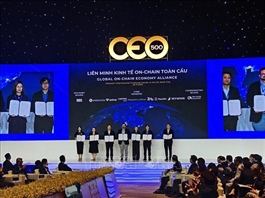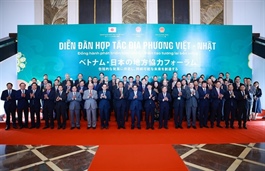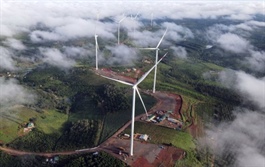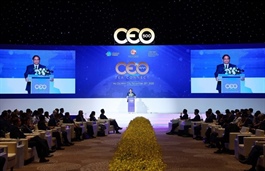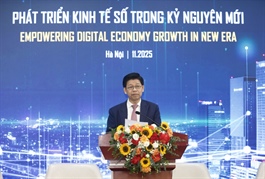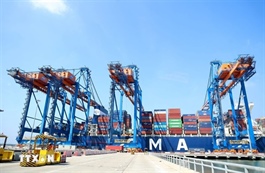Circular economy becoming architectural foundation
Circular economy becoming architectural foundation
The circular economy is increasingly becoming a driving force and playing a central role in Vietnam’s dual transition towards digitalisation and green transformation, serving as an essential pathway to achieving sustainability goals.
At a conference on the implementation of a circular economy in Vietnam on November 11 in Hanoi, Phi Vinh Tuong, deputy director of the Institute of World Economics and Politics, said that the topic has become a global trend as countries confront rising sea levels, climate change, and resource crises.
“For Vietnam, the circular economy is no longer an option but an inevitable pathway to meet sustainable development goals, fulfill its net-zero emissions commitment by 2050, and concretise the nation’s action plan on the issue by 2035,” he asserted.
Tuong pointed out numerous challenges in developing the circular economy in Vietnam, both in policy and implementation, warning that Vietnam risks being excluded from global value chains if it does not rapidly adopt relevant practices.
“Although several relevant economic development policies have been issued, they remain fragmented, lack sector-specific guidance, and lack mechanisms for intersectoral coordination. Recycling infrastructure and national material-flow databases are still weak, while enterprise capacity, especially among small and medium-sized enterprises, also remains limited,” he said.
Proposing solutions to accelerate development, Tuong explained the need to immediately improve governance frameworks for the circular economy, establish intersectoral coordination mechanisms, and prioritise relevant models in key sectors such as agriculture, processing and manufacturing, and urban development.
“Designing green financial mechanisms, encouraging related investment, and developing green credit systems and circular economy funds to support enterprises are also needed,” he said.
At the same event, Le Van Loi, president of the Vietnam Academy of Social Sciences, said the government’s approval of an action plan on the issue towards 2035 is a strategic step to translate key directions in the Law on Environmental Protection 2020, the green growth strategy, and the national climate change strategy into practice.
“The circular economy is becoming the architectural foundation for national development amid the dual transition of digitalisation and green transformation. It provides a pathway to reduce dependence on resource extraction, optimise energy use, and create economic value chains built on recycling, reuse, and technological innovation,” Loi said.
Meanwhile, Bui Quang Tuan, vice president of the Vietnam Economic Scientific Association, highlighted another limitation: Vietnam’s growth model still relies heavily on cheap labour, with limited spillover effects from foreign-invested enterprises, particularly in technological capabilities.
“Notably, contributions from science, technology, and innovation to economic growth remain modest. Vietnam has yet to participate deeply in global value chains, and its economy is not truly green. The circular economy is still in its early stages in certain sectors such as agriculture and eco-industrial parks,” he said.
Nguyen Dinh Dap of the Vietnam Academy of Social Sciences noted that most domestic enterprises lack the resources needed for the transition. Such development requires innovation, scientific application, and access to advanced technologies.
“To develop the circular economy, enterprises need teams of skilled experts capable of addressing challenges across the entire value chain. Therefore, the biggest puzzle for enterprises is securing financial resources to pursue green production and suitable business models,” he said.
To provide practical support, Dap suggested that the government should introduce incentives such as VAT reductions, tax exemptions, and subsidies to encourage circular business models. Initial financing support for enterprises is also essential to facilitate their transition towards relevant business practices.
Over the past decade, Vietnam has gradually built a policy foundation for the development of green banking, particularly following the government’s net-zero commitments made in 2021. The State Bank of Vietnam (SBV) has played a central role since issuing the green banking development scheme in 2018.
The scheme aimed that by 2025, at least 10 commercial banks had officially implemented green banking models and green credit accounts for at least 5 per cent of total outstanding loans in the economy.
According to the SBV, by the end of 2024, total outstanding green credit in Vietnam’s banking system reached approximately $25.5 billion, accounting for 4.5 per cent of total outstanding loans, 1.6 times higher than in 2021. State-owned commercial banks accounted for about 60 per cent of total green credit, demonstrating a clear shift in lending portfolios towards environmentally friendly sectors.
However, it was acknowledged at the November 11 event that implementation still faces limitations. Some guiding documents remain inconsistent across agencies, while appraisal procedures for green projects lack uniform standards. Additionally, Vietnam still lacks specific regulations on environmental, social, and governance disclosure, making monitoring and transparency difficult.
|
According to Vietnam’s action plan for the circular economy towards 2035, the country aims to build a sustainable production and consumption system, and promote efficient resource use. The roadmap prioritises the 2025-2030 period to reduce resource extraction and increase resource efficiency, achieving indicators comparable with leading ASEAN countries. The goal for 2035 is to establish a comprehensive and competitive circular economy and position Vietnam as a regional innovation hub in related development. Key targets include reducing the exploitation and use of non-renewable resources and water resources; improving the efficiency of resource, material, and energy use; and achieving ASEAN-leading indicators in the efficient use of land, water, and minerals. |
- 15:52 26/11/2025



